python接口自动化(2)unittest模块
unittest模块
unittest官方文档:https://docs.python.org/zh-cn/3.7/library/unittest.html#assert-methods
Unittest是python里面 的单元测试框架,方便组建测试用例,一键执行用例,并生成可视化测试报告
unittest最核心的四部分是:TestCase,TestSuite,TestRunner,TestFixture
TestCase:用户自定义的测试case的基类,调用run()方法,会依次调用setUp方法、执行用例的方法、tearDown方法。TestSuite:测试用例集合,可以通过addTest()方法手动增加Test Case,也可以通过TestLoader自动添加Test Case,TestLoader在添加用例时,会没有顺序。TestRunner:运行测试用例的驱动类,可以执行TestCase,也可以执行TestSuite,执行后TestCase和TestSuite会自动管理TESTResult。TestFixture:简单来说就是做一些测试过程中需要准备的东西,比如创建临时的数据库,文件和目录等,其中setUp()和setDown()是最常用的方法
整个的流程就是首先要写好TestCase,然后由TestLoader加载TestCase到TestSuite,然后由TestTestRunner来运行TestSuite,运行的结果保存在TextTestReusult中,整个过程集成在unittest.main模块中。
使用TestCase
测试类,继承单元测试unittest.TestCase这个类。
import unittest
class Test1(unittest.TestCase):
@classmethod
def setUpClass(self):
print("setUpClass初始化操作:用例开始前只执行一次")
print("execute setUpClass")
@classmethod
def tearDownClass(self):
print("tearDownClass收尾清理操作:用例结束时候只执行一次")
print("execute tearDownClass")
def setUp(self):
print("setUp每次用例开始前都会执行!!!")
print("execute setUp")
def tearDown(self):
print("tearDown每次用例结构都会执行!!!")
print("execute tearDown")
def test_one(self):
print('execute test_one')
self.assertTrue('FOO'.isupper())
def test_two(self):
print('execute test_two')
if __name__ == '__main__':
unittest.main()
运行结果为:
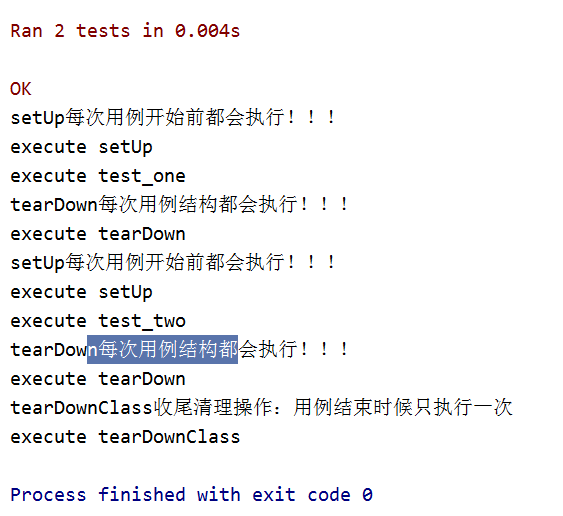
注意:写测试用例(函数)时,命名必须是以test开头!!!否则用例不会被执行。
使用TestSuite
直接写TestCase执行时是按字母排序的顺序执行的,如果要设定测试用例的执行先后顺序则需要将TestCase封装到TestSuite。
代码如下:
import unittest
import unittest
class Test2(unittest.TestCase):
@classmethod
def setUpClass(self):
print("setUpClass初始化操作:用例开始前只执行一次")
print("execute setUpClass")
@classmethod
def tearDownClass(self):
print("tearDownClass收尾清理操作:用例结束时候只执行一次")
print("execute tearDownClass")
def setUp(self):
print("setUp每次用例开始前都会执行!!!")
print("execute setUp")
def tearDown(self):
print("tearDown每次用例结构都会执行!!!")
print("execute tearDown")
def test_one(self):
print('execute test_one')
self.assertTrue('FOO'.isupper())
def test_two(self):
print('execute test_two')
if __name__ == '__main__':
suite=unittest.TestSuite()
suite.addTest(Test2('test_two'))
suite.addTest(Test2('test_one'))
runner=unittest.TextTestRunner()
runner.run(suite)
运行结果为:
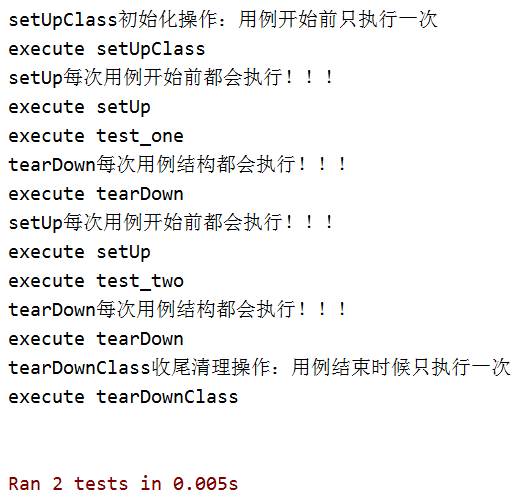
TestSuite注意事项
我们知道,TestSuite可以帮助我们自定义要运行的用例以及它们的顺序,但有时候会发现,尽管我们使用了TestSuite,但还是不会按照我们的顺序来运行测试用例,比如上面的实例。
原因是:运行方式!!!
在pycharm上点击如下按钮来运行unittest相关的脚本时:

会默认使用unittest in xxx的方式来运行脚本,不会去运行if __name__=='__main__'下面的内容,而是会按照ascii顺序去运行TestCase子类内定义的所有用例(函数)。

所以,我们需要改变运行方式,将运行环境改为 正常的python 环境(PS:就是不选择 unitest 的环境)再次运行脚本:
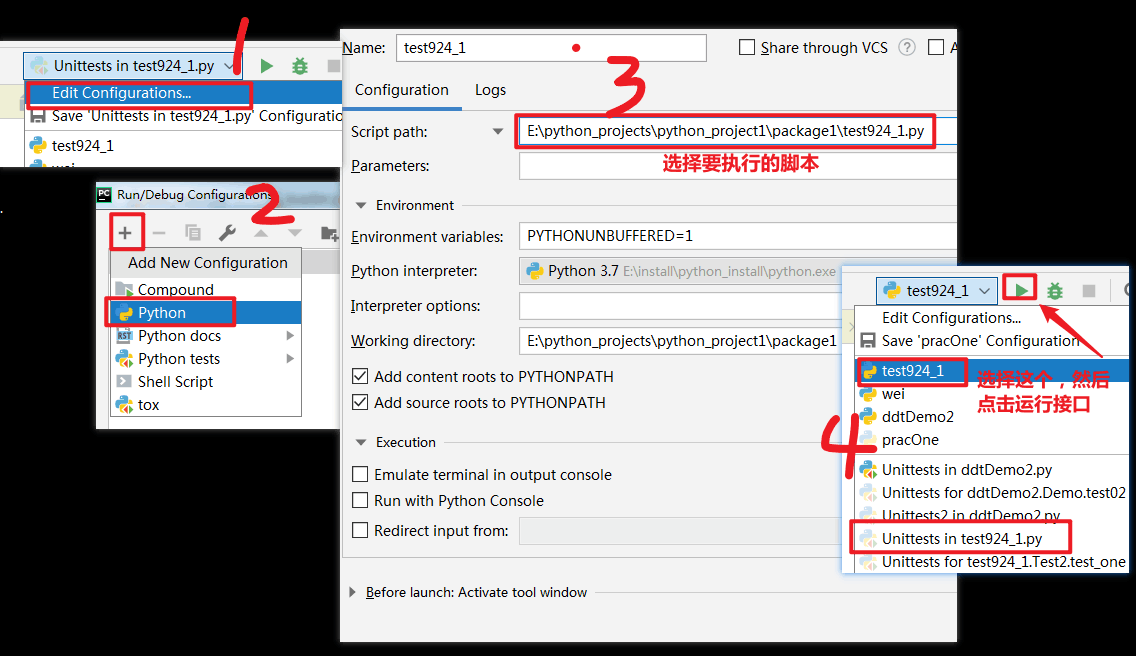
使用HTMLTestRunner
可使用HTMLTestRunner生成测试的HTML报告,HTMLTestRunner是Python标准库的unittest模块的扩展,无法通过pip安装。需要自己手动网上下载。
下载或创建了HTMLTestRunner.py文件后,可以将其放在python的lib目录下,也可以放在项目的某个package里面(只是导入方式改成from ... import ...而已)。
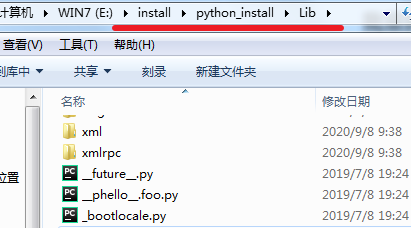
我使用的方法是直接放在lib目录下。
HTMLTestRunner.py代码
下载地址:http://tungwaiyip.info/software/HTMLTestRunner.html
适用于python3版本的HTMLTestRunner.py的代码可以如下,可以直接复制粘贴来创建:
"""
A TestRunner for use with the Python unit testing framework. It
generates a HTML report to show the result at a glance.
The simplest way to use this is to invoke its main method. E.g.
import unittest
import HTMLTestRunner
... define your tests ...
if __name__ == '__main__':
HTMLTestRunner.main()
For more customization options, instantiates a HTMLTestRunner object.
HTMLTestRunner is a counterpart to unittest's TextTestRunner. E.g.
# output to a file
fp = file('my_report.html', 'wb')
runner = HTMLTestRunner.HTMLTestRunner(
stream=fp,
title='My unit test',
description='This demonstrates the report output by HTMLTestRunner.'
)
# Use an external stylesheet.
# See the Template_mixin class for more customizable options
runner.STYLESHEET_TMPL = '<link rel="stylesheet" href="my_stylesheet.css" type="text/css">'
# run the test
runner.run(my_test_suite)
------------------------------------------------------------------------
Copyright (c) 2004-2007, Wai Yip Tung
All rights reserved.
Redistribution and use in source and binary forms, with or without
modification, are permitted provided that the following conditions are
met:
* Redistributions of source code must retain the above copyright notice,
this list of conditions and the following disclaimer.
* Redistributions in binary form must reproduce the above copyright
notice, this list of conditions and the following disclaimer in the
documentation and/or other materials provided with the distribution.
* Neither the name Wai Yip Tung nor the names of its contributors may be
used to endorse or promote products derived from this software without
specific prior written permission.
THIS SOFTWARE IS PROVIDED BY THE COPYRIGHT HOLDERS AND CONTRIBUTORS "AS
IS" AND ANY EXPRESS OR IMPLIED WARRANTIES, INCLUDING, BUT NOT LIMITED
TO, THE IMPLIED WARRANTIES OF MERCHANTABILITY AND FITNESS FOR A
PARTICULAR PURPOSE ARE DISCLAIMED. IN NO EVENT SHALL THE COPYRIGHT OWNER
OR CONTRIBUTORS BE LIABLE FOR ANY DIRECT, INDIRECT, INCIDENTAL, SPECIAL,
EXEMPLARY, OR CONSEQUENTIAL DAMAGES (INCLUDING, BUT NOT LIMITED TO,
PROCUREMENT OF SUBSTITUTE GOODS OR SERVICES; LOSS OF USE, DATA, OR
PROFITS; OR BUSINESS INTERRUPTION) HOWEVER CAUSED AND ON ANY THEORY OF
LIABILITY, WHETHER IN CONTRACT, STRICT LIABILITY, OR TORT (INCLUDING
NEGLIGENCE OR OTHERWISE) ARISING IN ANY WAY OUT OF THE USE OF THIS
SOFTWARE, EVEN IF ADVISED OF THE POSSIBILITY OF SUCH DAMAGE.
"""
# URL: http://tungwaiyip.info/software/HTMLTestRunner.html
__author__ = "Wai Yip Tung"
__version__ = "0.8.2"
"""
Change History
Version 0.8.2
* Show output inline instead of popup window (Viorel Lupu).
Version in 0.8.1
* Validated XHTML (Wolfgang Borgert).
* Added description of test classes and test cases.
Version in 0.8.0
* Define Template_mixin class for customization.
* Workaround a IE 6 bug that it does not treat <script> block as CDATA.
Version in 0.7.1
* Back port to Python 2.3 (Frank Horowitz).
* Fix missing scroll bars in detail log (Podi).
"""
# TODO: color stderr
# TODO: simplify javascript using ,ore than 1 class in the class attribute?
import datetime
#2.7版本为 import StringIO
import io
import sys
import time
import unittest
from xml.sax import saxutils
# ------------------------------------------------------------------------
# The redirectors below are used to capture output during testing. Output
# sent to sys.stdout and sys.stderr are automatically captured. However
# in some cases sys.stdout is already cached before HTMLTestRunner is
# invoked (e.g. calling logging.basicConfig). In order to capture those
# output, use the redirectors for the cached stream.
#
# e.g.
# >>> logging.basicConfig(stream=HTMLTestRunner.stdout_redirector)
# >>>
class OutputRedirector(object):
""" Wrapper to redirect stdout or stderr """
def __init__(self, fp):
self.fp = fp
def write(self, s):
self.fp.write(s)
def writelines(self, lines):
self.fp.writelines(lines)
def flush(self):
self.fp.flush()
stdout_redirector = OutputRedirector(sys.stdout)
stderr_redirector = OutputRedirector(sys.stderr)
# ----------------------------------------------------------------------
# Template
class Template_mixin(object):
"""
Define a HTML template for report customerization and generation.
Overall structure of an HTML report
HTML
+------------------------+
|<html> |
| <head> |
| |
| STYLESHEET |
| +----------------+ |
| | | |
| +----------------+ |
| |
| </head> |
| |
| <body> |
| |
| HEADING |
| +----------------+ |
| | | |
| +----------------+ |
| |
| REPORT |
| +----------------+ |
| | | |
| +----------------+ |
| |
| ENDING |
| +----------------+ |
| | | |
| +----------------+ |
| |
| </body> |
|</html> |
+------------------------+
"""
STATUS = {
0: 'pass',
1: 'fail',
2: 'error',
}
DEFAULT_TITLE = 'Unit Test Report'
DEFAULT_DESCRIPTION = ''
# ------------------------------------------------------------------------
# HTML Template
HTML_TMPL = r"""<?xml version="1.0" encoding="UTF-8"?>
<!DOCTYPE html PUBLIC "-//W3C//DTD XHTML 1.0 Strict//EN" "http://www.w3.org/TR/xhtml1/DTD/xhtml1-strict.dtd">
<html xmlns="http://www.w3.org/1999/xhtml">
<head>
<title>%(title)s</title>
<meta name="generator" content="%(generator)s"/>
<meta http-equiv="Content-Type" content="text/html; charset=UTF-8"/>
%(stylesheet)s
</head>
<body>
<script language="javascript" type="text/javascript"><!--
output_list = Array();
/* level - 0:Summary; 1:Failed; 2:All */
function showCase(level) {
trs = document.getElementsByTagName("tr");
for (var i = 0; i < trs.length; i++) {
tr = trs[i];
id = tr.id;
if (id.substr(0,2) == 'ft') {
if (level < 1) {
tr.className = 'hiddenRow';
}
else {
tr.className = '';
}
}
if (id.substr(0,2) == 'pt') {
if (level > 1) {
tr.className = '';
}
else {
tr.className = 'hiddenRow';
}
}
}
}
function showClassDetail(cid, count) {
var id_list = Array(count);
var toHide = 1;
for (var i = 0; i < count; i++) {
tid0 = 't' + cid.substr(1) + '.' + (i+1);
tid = 'f' + tid0;
tr = document.getElementById(tid);
if (!tr) {
tid = 'p' + tid0;
tr = document.getElementById(tid);
}
id_list[i] = tid;
if (tr.className) {
toHide = 0;
}
}
for (var i = 0; i < count; i++) {
tid = id_list[i];
if (toHide) {
document.getElementById('div_'+tid).style.display = 'none'
document.getElementById(tid).className = 'hiddenRow';
}
else {
document.getElementById(tid).className = '';
}
}
}
function showTestDetail(div_id){
var details_div = document.getElementById(div_id)
var displayState = details_div.style.display
// alert(displayState)
if (displayState != 'block' ) {
displayState = 'block'
details_div.style.display = 'block'
}
else {
details_div.style.display = 'none'
}
}
function html_escape(s) {
s = s.replace(/&/g,'&');
s = s.replace(/</g,'<');
s = s.replace(/>/g,'>');
return s;
}
/* obsoleted by detail in <div>
function showOutput(id, name) {
var w = window.open("", //url
name,
"resizable,scrollbars,status,width=800,height=450");
d = w.document;
d.write("<pre>");
d.write(html_escape(output_list[id]));
d.write("\n");
d.write("<a href='javascript:window.close()'>close</a>\n");
d.write("</pre>\n");
d.close();
}
*/
--></script>
%(heading)s
%(report)s
%(ending)s
</body>
</html>
"""
# variables: (title, generator, stylesheet, heading, report, ending)
# ------------------------------------------------------------------------
# Stylesheet
#
# alternatively use a <link> for external style sheet, e.g.
# <link rel="stylesheet" href="$url" type="text/css">
STYLESHEET_TMPL = """
<style type="text/css" media="screen">
body { font-family: verdana, arial, helvetica, sans-serif; font-size: 80%; }
table { font-size: 100%; }
pre { }
/* -- heading ---------------------------------------------------------------------- */
h1 {
font-size: 16pt;
color: gray;
}
.heading {
margin-top: 0ex;
margin-bottom: 1ex;
}
.heading .attribute {
margin-top: 1ex;
margin-bottom: 0;
}
.heading .description {
margin-top: 4ex;
margin-bottom: 6ex;
}
/* -- css div popup ------------------------------------------------------------------------ */
a.popup_link {
}
a.popup_link:hover {
color: red;
}
.popup_window {
display: none;
position: relative;
left: 0px;
top: 0px;
/*border: solid #627173 1px; */
padding: 10px;
background-color: #E6E6D6;
font-family: "Lucida Console", "Courier New", Courier, monospace;
text-align: left;
font-size: 8pt;
width: 500px;
}
}
/* -- report ------------------------------------------------------------------------ */
#show_detail_line {
margin-top: 3ex;
margin-bottom: 1ex;
}
#result_table {
width: 80%;
border-collapse: collapse;
border: 1px solid #777;
}
#header_row {
font-weight: bold;
color: white;
background-color: #777;
}
#result_table td {
border: 1px solid #777;
padding: 2px;
}
#total_row { font-weight: bold; }
.passClass { background-color: #6c6; }
.failClass { background-color: #c60; }
.errorClass { background-color: #c00; }
.passCase { color: #6c6; }
.failCase { color: #c60; font-weight: bold; }
.errorCase { color: #c00; font-weight: bold; }
.hiddenRow { display: none; }
.testcase { margin-left: 2em; }
/* -- ending ---------------------------------------------------------------------- */
#ending {
}
</style>
"""
# ------------------------------------------------------------------------
# Heading
#
HEADING_TMPL = """<div class='heading'>
<h1>%(title)s</h1>
%(parameters)s
<p class='description'>%(description)s</p>
</div>
""" # variables: (title, parameters, description)
HEADING_ATTRIBUTE_TMPL = """<p class='attribute'><strong>%(name)s:</strong> %(value)s</p>
""" # variables: (name, value)
# ------------------------------------------------------------------------
# Report
#
REPORT_TMPL = """
<p id='show_detail_line'>Show
<a href='javascript:showCase(0)'>Summary</a>
<a href='javascript:showCase(1)'>Failed</a>
<a href='javascript:showCase(2)'>All</a>
</p>
<table id='result_table'>
<colgroup>
<col align='left' />
<col align='right' />
<col align='right' />
<col align='right' />
<col align='right' />
<col align='right' />
</colgroup>
<tr id='header_row'>
<td>Test Group/Test case</td>
<td>Count</td>
<td>Pass</td>
<td>Fail</td>
<td>Error</td>
<td>View</td>
</tr>
%(test_list)s
<tr id='total_row'>
<td>Total</td>
<td>%(count)s</td>
<td>%(Pass)s</td>
<td>%(fail)s</td>
<td>%(error)s</td>
<td> </td>
</tr>
</table>
""" # variables: (test_list, count, Pass, fail, error)
REPORT_CLASS_TMPL = r"""
<tr class='%(style)s'>
<td>%(desc)s</td>
<td>%(count)s</td>
<td>%(Pass)s</td>
<td>%(fail)s</td>
<td>%(error)s</td>
<td><a href="javascript:showClassDetail('%(cid)s',%(count)s)">Detail</a></td>
</tr>
""" # variables: (style, desc, count, Pass, fail, error, cid)
REPORT_TEST_WITH_OUTPUT_TMPL = r"""
<tr id='%(tid)s' class='%(Class)s'>
<td class='%(style)s'><div class='testcase'>%(desc)s</div></td>
<td colspan='5' align='center'>
<!--css div popup start-->
<a class="popup_link" onfocus='this.blur();' href="javascript:showTestDetail('div_%(tid)s')" >
%(status)s</a>
<div id='div_%(tid)s' class="popup_window">
<div style='text-align: right; color:red;cursor:pointer'>
<a onfocus='this.blur();' onclick="document.getElementById('div_%(tid)s').style.display = 'none' " >
[x]</a>
</div>
<pre>
%(script)s
</pre>
</div>
<!--css div popup end-->
</td>
</tr>
""" # variables: (tid, Class, style, desc, status)
REPORT_TEST_NO_OUTPUT_TMPL = r"""
<tr id='%(tid)s' class='%(Class)s'>
<td class='%(style)s'><div class='testcase'>%(desc)s</div></td>
<td colspan='5' align='center'>%(status)s</td>
</tr>
""" # variables: (tid, Class, style, desc, status)
REPORT_TEST_OUTPUT_TMPL = r"""
%(id)s: %(output)s
""" # variables: (id, output)
# ------------------------------------------------------------------------
# ENDING
#
ENDING_TMPL = """<div id='ending'> </div>"""
# -------------------- The end of the Template class -------------------
TestResult = unittest.TestResult
class _TestResult(TestResult):
# note: _TestResult is a pure representation of results.
# It lacks the output and reporting ability compares to unittest._TextTestResult.
def __init__(self, verbosity=1):
TestResult.__init__(self)
self.stdout0 = None
self.stderr0 = None
self.success_count = 0
self.failure_count = 0
self.error_count = 0
self.verbosity = verbosity
# result is a list of result in 4 tuple
# (
# result code (0: success; 1: fail; 2: error),
# TestCase object,
# Test output (byte string),
# stack trace,
# )
self.result = []
def startTest(self, test):
TestResult.startTest(self, test)
# just one buffer for both stdout and stderr
# 2.7版本为 self.outputBuffer = StringIO.StringIO()
self.outputBuffer = io.StringIO()
stdout_redirector.fp = self.outputBuffer
stderr_redirector.fp = self.outputBuffer
self.stdout0 = sys.stdout
self.stderr0 = sys.stderr
sys.stdout = stdout_redirector
sys.stderr = stderr_redirector
def complete_output(self):
"""
Disconnect output redirection and return buffer.
Safe to call multiple times.
"""
if self.stdout0:
sys.stdout = self.stdout0
sys.stderr = self.stderr0
self.stdout0 = None
self.stderr0 = None
return self.outputBuffer.getvalue()
def stopTest(self, test):
# Usually one of addSuccess, addError or addFailure would have been called.
# But there are some path in unittest that would bypass this.
# We must disconnect stdout in stopTest(), which is guaranteed to be called.
self.complete_output()
def addSuccess(self, test):
self.success_count += 1
TestResult.addSuccess(self, test)
output = self.complete_output()
self.result.append((0, test, output, ''))
if self.verbosity > 1:
sys.stderr.write('ok ')
sys.stderr.write(str(test))
sys.stderr.write('\n')
else:
sys.stderr.write('.')
def addError(self, test, err):
self.error_count += 1
TestResult.addError(self, test, err)
_, _exc_str = self.errors[-1]
output = self.complete_output()
self.result.append((2, test, output, _exc_str))
if self.verbosity > 1:
sys.stderr.write('E ')
sys.stderr.write(str(test))
sys.stderr.write('\n')
else:
sys.stderr.write('E')
def addFailure(self, test, err):
self.failure_count += 1
TestResult.addFailure(self, test, err)
_, _exc_str = self.failures[-1]
output = self.complete_output()
self.result.append((1, test, output, _exc_str))
if self.verbosity > 1:
sys.stderr.write('F ')
sys.stderr.write(str(test))
sys.stderr.write('\n')
else:
sys.stderr.write('F')
class HTMLTestRunner(Template_mixin):
"""
"""
def __init__(self, stream=sys.stdout, verbosity=1, title=None, description=None):
self.stream = stream
self.verbosity = verbosity
if title is None:
self.title = self.DEFAULT_TITLE
else:
self.title = title
if description is None:
self.description = self.DEFAULT_DESCRIPTION
else:
self.description = description
self.startTime = datetime.datetime.now()
def run(self, test):
"Run the given test case or test suite."
result = _TestResult(self.verbosity)
test(result)
self.stopTime = datetime.datetime.now()
self.generateReport(test, result)
print(sys.stderr,'\nTime Elapsed=%s' %(self.stopTime-self.startTime))
#2.7版本 print >>sys.stderr, '\nTime Elapsed: %s' % (self.stopTime-self.startTime)
return result
def sortResult(self, result_list):
# unittest does not seems to run in any particular order.
# Here at least we want to group them together by class.
rmap = {}
classes = []
for n,t,o,e in result_list:
cls = t.__class__
# 2.7版本 if not rmap.has_key(cls)
if not cls in rmap:
rmap[cls] = []
classes.append(cls)
rmap[cls].append((n,t,o,e))
r = [(cls, rmap[cls]) for cls in classes]
return r
def getReportAttributes(self, result):
"""
Return report attributes as a list of (name, value).
Override this to add custom attributes.
"""
startTime = str(self.startTime)[:19]
duration = str(self.stopTime - self.startTime)
status = []
if result.success_count: status.append('Pass %s' % result.success_count)
if result.failure_count: status.append('Failure %s' % result.failure_count)
if result.error_count: status.append('Error %s' % result.error_count )
if status:
status = ' '.join(status)
else:
status = 'none'
return [
('Start Time', startTime),
('Duration', duration),
('Status', status),
]
def generateReport(self, test, result):
report_attrs = self.getReportAttributes(result)
generator = 'HTMLTestRunner %s' % __version__
stylesheet = self._generate_stylesheet()
heading = self._generate_heading(report_attrs)
report = self._generate_report(result)
ending = self._generate_ending()
output = self.HTML_TMPL % dict(
title = saxutils.escape(self.title),
generator = generator,
stylesheet = stylesheet,
heading = heading,
report = report,
ending = ending,
)
self.stream.write(output.encode('utf8'))
def _generate_stylesheet(self):
return self.STYLESHEET_TMPL
def _generate_heading(self, report_attrs):
a_lines = []
for name, value in report_attrs:
line = self.HEADING_ATTRIBUTE_TMPL % dict(
name = saxutils.escape(name),
value = saxutils.escape(value),
)
a_lines.append(line)
heading = self.HEADING_TMPL % dict(
title = saxutils.escape(self.title),
parameters = ''.join(a_lines),
description = saxutils.escape(self.description),
)
return heading
def _generate_report(self, result):
rows = []
sortedResult = self.sortResult(result.result)
for cid, (cls, cls_results) in enumerate(sortedResult):
# subtotal for a class
np = nf = ne = 0
for n,t,o,e in cls_results:
if n == 0: np += 1
elif n == 1: nf += 1
else: ne += 1
# format class description
if cls.__module__ == "__main__":
name = cls.__name__
else:
name = "%s.%s" % (cls.__module__, cls.__name__)
doc = cls.__doc__ and cls.__doc__.split("\n")[0] or ""
desc = doc and '%s: %s' % (name, doc) or name
row = self.REPORT_CLASS_TMPL % dict(
style = ne > 0 and 'errorClass' or nf > 0 and 'failClass' or 'passClass',
desc = desc,
count = np+nf+ne,
Pass = np,
fail = nf,
error = ne,
cid = 'c%s' % (cid+1),
)
rows.append(row)
for tid, (n,t,o,e) in enumerate(cls_results):
self._generate_report_test(rows, cid, tid, n, t, o, e)
report = self.REPORT_TMPL % dict(
test_list = ''.join(rows),
count = str(result.success_count+result.failure_count+result.error_count),
Pass = str(result.success_count),
fail = str(result.failure_count),
error = str(result.error_count),
)
return report
def _generate_report_test(self, rows, cid, tid, n, t, o, e):
# e.g. 'pt1.1', 'ft1.1', etc
has_output = bool(o or e)
tid = (n == 0 and 'p' or 'f') + 't%s.%s' % (cid+1,tid+1)
name = t.id().split('.')[-1]
doc = t.shortDescription() or ""
desc = doc and ('%s: %s' % (name, doc)) or name
tmpl = has_output and self.REPORT_TEST_WITH_OUTPUT_TMPL or self.REPORT_TEST_NO_OUTPUT_TMPL
# o and e should be byte string because they are collected from stdout and stderr?
if isinstance(o,str):
uo = e
# TODO: some problem with 'string_escape': it escape \n and mess up formating
# uo = unicode(o.encode('string_escape'))
# 2.7版本uo = o.decode('latin-1')
else:
uo = o
if isinstance(e,str):
ue = e
# TODO: some problem with 'string_escape': it escape \n and mess up formating
# ue = unicode(e.encode('string_escape'))
# 2.7 版本 ue = e.decode('latin-1')
else:
ue = e
script = self.REPORT_TEST_OUTPUT_TMPL % dict(
id = tid,
output = saxutils.escape(uo+ue),
)
row = tmpl % dict(
tid = tid,
Class = (n == 0 and 'hiddenRow' or 'none'),
style = n == 2 and 'errorCase' or (n == 1 and 'failCase' or 'none'),
desc = desc,
script = script,
status = self.STATUS[n],
)
rows.append(row)
if not has_output:
return
def _generate_ending(self):
return self.ENDING_TMPL
##############################################################################
# Facilities for running tests from the command line
##############################################################################
# Note: Reuse unittest.TestProgram to launch test. In the future we may
# build our own launcher to support more specific command line
# parameters like test title, CSS, etc.
class TestProgm(unittest.TestProgram):
"""
A variation of the unittest.TestProgram. Please refer to the base
class for command line parameters.
"""
def runTests(self):
# Pick HTMLTestRunner as the default test runner.
# base class's testRunner parameter is not useful because it means
# we have to instantiate HTMLTestRunner before we know self.verbosity.
if self.testRunner is None:
self.testRunner = HTMLTestRunner(verbosity=self.verbosity)
unittest.TestProgram.runTests(self)
main = TestProgram
##############################################################################
# Executing this module from the command line
##############################################################################
if __name__ == "__main__":
main(module=None)
生成报告实例
第一步:首先新建一个package,命名为report,专门存放生成的测试报告。
第二步:编写代码:
import unittest
import HTMLTestRunner
class HtmlDemo(unittest.TestCase):
def setUp(self) -> None:
pass
def test_one(self):
self.assertEqual(2+10,12)
def test_two(self):
self.assertEqual(10 + 150,160)
def tearDown(self) -> None:
pass
if __name__=='__main__':
hd=HtmlDemo()
suiteTest=unittest.TestSuite()
suiteTest.addTest(HtmlDemo("test_one"))
suiteTest.addTest(HtmlDemo("test_two"))
filepath='report/htmlDemo.html'
fp=open(filepath,'wb')
runner=HTMLTestRunner.HTMLTestRunner(stream=fp,title='测试报告',description='我的第一个html测试报告')
runner.run(suiteTest)
fp.close()
生成的HTML报告如下:

解释:
stream:测试报告写入文件的存储区域title:测试报告的主题description:测试报告的描述
批量执行测试脚本
第一步:创建一个清晰的项目结构
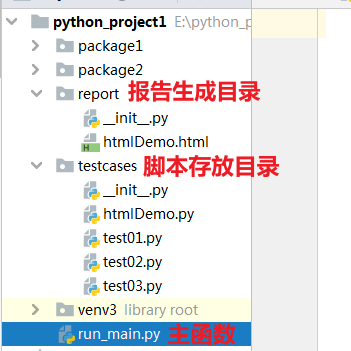
第二步:编写多个测试.py脚本
test01.py
import unittest
import requests
class Testqq(unittest.TestCase):
def setUp(self) -> None:
self.s=requests.Session()
self.url='http://japi.juhe.cn/qqevaluate/qq'
def test01(self):
'''用例1:错误的key'''
par={
"key":"xxx",
"qq":"283340479"
}
r=self.s.get(self.url,params=par)
print("测试返回结果{}".format(r.text))
#获取返回结果
result=r.json()["reason"]
#断言:
try:
self.assertTrue(result=="KEY ERROR!")
except Exception:
print("这个用例测试不能通过")
def test02(self):
'''用例1:正确的key'''
par={
"key":"8dbee1fcd8627fb6699bce7b986adc45",
"qq":"283340479"
}
r=self.s.get(self.url,params=par)
print("测试返回结果{}".format(r.text))
#获取返回结果
result=r.json()["reason"]
#断言:
try:
self.assertTrue(result=="success")
except Exception:
print("这个用例测试不能通过")
def test03(self):
'''用例1:错误的qq请求参数'''
par={
"key":"8dbee1fcd8627fb6699bce7b986adc45",
"qq":"22xx"
}
r=self.s.get(self.url,params=par)
print("测试返回结果{}".format(r.text))
#获取返回结果
result=r.json()["reason"]
print(type(result))
print(result)
print(result=="错误的请求参数")
#断言:
try:
self.assertTrue(result=="错误的请求参数")
except Exception:
print("这个用例测试不能通过")
def tearDown(self) -> None:
self.s.close()
if __name__=='__main__':
unittest.main()
这里提前讲一下断言的东西:使用断言时,如果断言失败(不是运行失败)就会抛出异常

所以,在建议用try...except...把断言包起来。观察其中一种断言的源代码,比如unittest.assertTrue()的源代码,我们也可以看到,确实回抛出异常:

test02.py:
import unittest
import HTMLTestRunner
class HtmlDemo(unittest.TestCase):
def setUp(self) -> None:
pass
def test_one(self):
try:
self.assertEqual(2+10,12)
except Exception:
print("断言失败")
def test_two(self):
try:
self.assertEqual(10 + 150,160)
except Exception:
print("断言失败")
def tearDown(self) -> None:
pass
第三步:编写主函数
rum_main.py:
# coding=utf-8
import HTMLTestRunner
import unittest
import os
def addTests():
basepath=os.path.realpath(os.path.dirname(__file__))
case_dir=os.path.join(basepath,"testcases")
suite=unittest.defaultTestLoader.discover(
start_dir=case_dir,
pattern='test*.py',
top_level_dir=None
)
return suite
if __name__=='__main__':
runner=unittest.TextTestRunner()
runner.run(addTests())
解释:
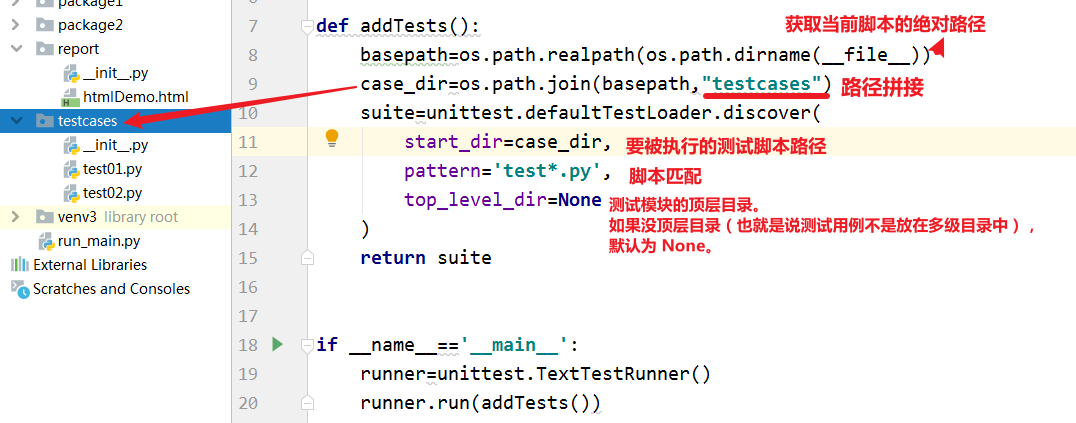
unittest的assert断言
unittest模块包含的断言方法如下:
| Method | Checks that | New in |
|---|---|---|
assertEqual(a, b) |
a == b |
|
assertNotEqual(a, b) |
a != b |
|
assertTrue(x) |
bool(x) is True |
|
assertFalse(x) |
bool(x) is False |
|
assertIs(a, b) |
a is b |
3.1 |
assertIsNot(a, b) |
a is not b |
3.1 |
assertIsNone(x) |
x is None |
3.1 |
assertIsNotNone(x) |
x is not None |
3.1 |
assertIn(a, b) |
a in b |
3.1 |
assertNotIn(a, b) |
a not in b |
3.1 |
assertIsInstance(a, b) |
isinstance(a, b) |
3.2 |
assertNotIsInstance(a, b) |
not isinstance(a, b) |
3.2 |
新版本的方法:
| Method | Checks that | New in |
|---|---|---|
assertRaises(exc, fun, *args, **kwds) |
fun(*args, **kwds) raises exc |
|
assertRaisesRegex(exc, r, fun, *args, **kwds) |
fun(*args, **kwds) raises exc and the message matches regex r |
3.1 |
assertWarns(warn, fun, *args, **kwds) |
fun(*args, **kwds) raises warn |
3.2 |
assertWarnsRegex(warn, r, fun, *args, **kwds) |
fun(*args, **kwds) raises warn and the message matches regex r |
3.2 |
assertLogs(logger, level) |
The with block logs on logger with minimum level |
3.4 |


 浙公网安备 33010602011771号
浙公网安备 33010602011771号